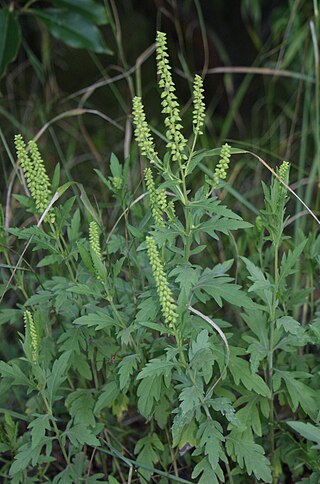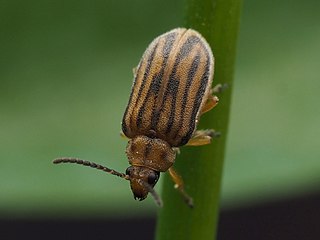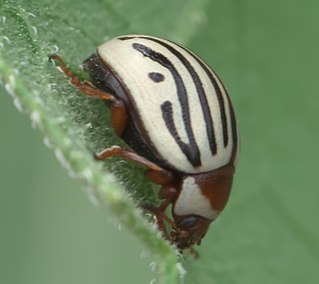
Beetles are insects that form the order Coleoptera, in the superorder Endopterygota. Their front pair of wings are hardened into wing-cases, elytra, distinguishing them from most other insects. The Coleoptera, with about 400,000 described species, is the largest of all orders, constituting almost 40% of described insects and 25% of all known animal species; new species are discovered frequently, with estimates suggesting that there are between 0.9 and 2.1 million total species. Found in almost every habitat except the sea and the polar regions, they interact with their ecosystems in several ways: beetles often feed on plants and fungi, break down animal and plant debris, and eat other invertebrates. Some species are serious agricultural pests, such as the Colorado potato beetle, while others such as Coccinellidae eat aphids, scale insects, thrips, and other plant-sucking insects that damage crops.

Ragweeds are flowering plants in the genus Ambrosia in the aster family, Asteraceae. They are distributed in the tropical and subtropical regions of the Americas, especially North America, where the origin and center of diversity of the genus are in the southwestern United States and northwestern Mexico. Several species have been introduced to the Old World and some have naturalized and have become invasive species. Ragweed species are expected to continue spreading across Europe in the near future in response to ongoing climate change.
Ambrosia beetles are beetles of the weevil subfamilies Scolytinae and Platypodinae, which live in nutritional symbiosis with ambrosia fungi. The beetles excavate tunnels in dead, stressed, and healthy trees in which they cultivate fungal gardens, their sole source of nutrition. After landing on a suitable tree, an ambrosia beetle excavates a tunnel in which it releases spores of its fungal symbiont. The fungus penetrates the plant's xylem tissue, extracts nutrients from it, and concentrates the nutrients on and near the surface of the beetle gallery. Ambrosia fungi are typically poor wood degraders, and instead utilize less demanding nutrients. Symbiotic fungi produce and detoxify ethanol, which is an attractant for Ambrosia beetles and likely prevents growth of antagonistic pathogens and selects for other beneficial symbionts. The majority of ambrosia beetles colonize xylem of recently dead trees, but some attack stressed trees that are still alive, and a few species attack healthy trees. Species differ in their preference for different parts of trees, different stages of deterioration, and in the shape of their tunnels ("galleries"). However, the majority of ambrosia beetles are not specialized to any taxonomic group of hosts, unlike most phytophagous organisms including the closely related bark beetles. One species of ambrosia beetle, Austroplatypus incompertus exhibits eusociality, one of the few organisms outside of Hymenoptera and Isoptera to do so.

Ambrosia artemisiifolia, with the common names common ragweed, annual ragweed, and low ragweed, is a species of the genus Ambrosia native to regions of the Americas.

The term mycangium is used in biology for special structures on the body of an animal that are adapted for the transport of symbiotic fungi. This is seen in many xylophagous insects, which apparently derive much of their nutrition from the digestion of various fungi that are growing amidst the wood fibers. In some cases, as in ambrosia beetles, the fungi are the sole food, and the excavations in the wood are simply to make a suitable microenvironment for the fungus to grow. In other cases, wood tissue is the main food, and fungi weaken the defense response from the host plant.

The Chrysomelinae are a subfamily of leaf beetles (Chrysomelidae), commonly known as broad-bodied leaf beetles or broad-shouldered leaf beetles. It includes some 3,000 species around the world.

Zygogramma is a large genus of leaf beetles in the subfamily Chrysomelinae, which includes approximately 100 species. 13 species occur north of Mexico.

Ambrosia psilostachya is a species of ragweed known by the common names Cuman ragweed and perennial ragweed, and western ragweed.
Ambrosiella is a genus of ambrosia fungi within the family Ceratocystidaceae. It was circumscribed by mycologists Josef Adolph von Arx and Grégoire L. Hennebert in 1965 with Ambrosiella xylebori as the type species. All Ambrosiella species are obligate symbionts of ambrosia beetles. Several former species were moved to Raffaelea, Hyalorhinocladiella, or Phialophoropsis and there are nine species recognized as of 2017. One species, Ambrosiella cleistominuta, has been observed to produce a fertile sexual state with cleistothecious ascomata.

Ophraella communa, common name ragweed leaf beetle, is a species of beetles belonging to the family Chrysomelidae.
Zygogramma arizonica is a species of beetle belonging to the family Zygogramma.

Zygogramma conjuncta is a species of beetle belonging to the family Zygogramma.
Zygogramma continua is a species of beetle belonging to the family Zygogramma.

Zygogramma exclamationis, commonly known as the sunflower beetle, is a species of leaf beetle belonging to the family Zygogramma. It is regarded as a pest of sunflower crops in North America.

Zygogramma suturalis, commonly known as the ragweed leaf beetle, is a species of leaf beetle belonging to the genus Zygogramma. Native to North America, it has been introduced into Russia and China for the biological pest control of ragweed.
Zygogramma heterothecae is a species of beetle belonging to the family Zygogramma.

Zygogramma piceicollis is a species of leaf beetle in the family Chrysomelidae. It is found in Central America, North America, and Europe.

Zygogramma signatipennis is a species of leaf beetle in the family Chrysomelidae. It is found in Central America and North America.

Zygogramma tortuosa, the ambrosia leaf beetle, is a species of leaf beetle in the family Chrysomelidae. It is found in Central America and North America.
Zygogramma malvae is a species of leaf beetle in the family Chrysomelidae. It is found in Central America and North America.













